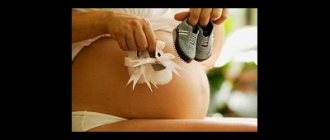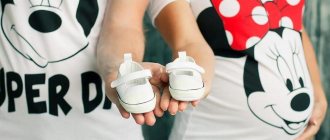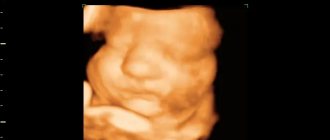- Morula stage
- Blastocyst stage
When talking about the origin of life and the formation of the body of a future child (that is, what embryology studies), it makes sense to describe the development of a human embryo by weeks, and in the early stages even by days. In the embryology laboratory of the clinic, where ART methods are used to treat infertility, the development of a human embryo is carried out at an early stage: from the moment of fertilization to the blastocyst stage.
How embryo development will proceed in a laboratory depends not only on the professionalism of the employees, the quality of the equipment used, culture media and other consumables, but also, first of all, on the quality of the gametes (sex cells).
Patients are often interested in how an embryo develops day by day from conception, and in this article we will list the stages of development of a human embryo in the early stages.
A certain set of “aggressive” environmental factors negatively affects the quality of germ cells. Stress, smoking, drinking alcohol, various infections and much more lead to disorders in the reproductive system. With age, the ovarian reserve decreases and, accordingly, there is less chance of receiving a high-quality egg. In men over 45 years of age, the main parameters of sperm (concentration, motility, morphology) also deteriorate significantly.
With the use of ART methods in the treatment of infertility, the chances of getting the desired pregnancy increase significantly. As a result of ovarian stimulation, several oocytes are obtained from a woman during transvaginal ovarian puncture (TVOP). All conditions have been created for the cultivation of embryos in our clinic: an appropriate ventilation system, temperature conditions, the latest equipment and culture media (Origio, Denmark; SOOK, Austria) from the world's leading manufacturers, non-embryotoxic plastic (NUNC, Falcon, USA), a team of professionals. All manipulations and cultivation of embryos are carried out in a culture medium corresponding to the stage of embryo development, coated with mineral oil (Origio, Denmark), which acts as a physical barrier separating the medium from various particles and pathogens contained in the air, and also maintains the temperature and osmolarity of the medium, protecting against significant fluctuations in the microenvironment.
Let's look at the stages of development of a human embryo.
Embryo development before IVF
With artificial conception, the gestational age is calculated not from the day of fertilization, but from the moment the IVF embryo is implanted into the uterus.
However, by the time of implantation, the embryo exists and develops for 8 days. Scientists have long studied how an IVF embryo is formed, and even took pictures of the development of the embryo on each day. For about a week of IVF, the embryo grows “in vitro”. During this period, doctors assess its viability and identify developmental abnormalities. After all, in order for pregnancy to occur, the embryo must form correctly. Actually, fertilization takes place only if the embryo has developed correctly for 8 days spent in the laboratory, without deviations. If the “wrong” embryo is formed, conception will not occur. What happens to an IVF embryo in the first days after fertilization? In the table you can see how and on what day the embryo develops.
| Day | State of the embryo |
| 0 (zero) | Doctors perform direct fertilization |
| 1 | Experts assess the presence of female and male nuclei |
| 2 | Experts evaluate the quality of the embryo by shape, fragmentation and size |
| 3 | During this period, you need to check whether the embryo includes 8 daughter cells |
| 4 | The number of daughter cells should increase to 10-16 pieces. The surface of the embryo becomes smooth |
| 5 and 6 | The embryo must develop into a blastocyst |
When the development of the “in vitro” embryo ends, the embryo is transplanted into the uterus. This is the end of the IVF stage: in order for pregnancy to occur, the embryo is implanted into the woman’s uterus. It is difficult to say on what day the embryo begins to be felt by the mother. But in the first days after IVF, you may feel slight discomfort or tingling in the abdomen. The implantation process takes on average 40 hours. But even if the doctor did everything correctly and introduced the embryo, conception may not happen. Implantation does not guarantee pregnancy; you need to wait some time to make sure that the procedure has given the desired result. But at the IVF Center clinic in Smolensk, specialists closely monitor the formation of embryos, creating the necessary temperature conditions and other important conditions that can affect the process. Therefore, our clinic has positive statistics of successfully performed IVF.
38–42 weeks of fetal development
By this time, the fetus is considered mature and ready for birth. The child mastered more than 70 different reflexes. A subcutaneous fat layer has appeared, the skin has a pale pink color. The head is covered with three-centimeter hairs.
The marigolds have grown and are already protruding beyond the edges of the fingers. The cartilages on the nose and ears have become elastic. The genitals are finally formed: the labia majora in girls have already covered the labia minora, and in boys the testicles have descended into the scrotum.
The child recognizes the mother’s mood (joy, delight, anxiety) and reacts to it with his movements. During the period of intrauterine development, the baby is so accustomed to moving in space that after birth, rocking and being carried in the arms is a natural state for him. This quickly calms the baby down and helps him fall asleep quickly.
The baby's weight reaches an average of 3200-3600 g, length is 480-520 mm.
After birth, the child lacks touches on his body, because at first he does not know how to touch himself, his arms and legs cannot be clearly controlled, as they were in the tummy. To make a child feel safe and comfortable, you need to take him in your arms, hold him closer to you, always be there, stroke him and talk to him.
Advice to future parents: the baby remembers the rhythm of his mother’s heart. When you need to console him, just take him in your arms and place him on your left side, closer to your heart. The child will hear a familiar rhythm, calm down and fall asleep.
Did you like the post? Be sure to tell your friends on social networks about this interesting article:
- VKontakte
- Google+
2 PS If you liked the article, please click the social media buttons.
fetusweeklydevelopment
On what day is an embryo detected by a pregnancy test?
Sometimes women, immediately after the procedure, feel as if they feel a pregnancy, an embryo inside. However, there is no need to immediately run to the pharmacy and buy a test after the procedure. Even if a woman thinks she feels the embryo, conception may not have occurred. You can find out whether the operation was successful after 2 weeks. Successful fertilization can be confirmed by a routine pregnancy test or a laboratory test for hCG levels. There is no point in doing the test earlier, as it may give a false positive result due to hormonal therapy. Therefore, you should be patient and believe that conception has successfully occurred. Belief in success and calmness are necessary to achieve results, because a woman’s psychological tension can disrupt conception and negatively affect the IVF embryo. It is necessary to remain optimistic. Conception will definitely happen, even if not on the first try.
Starting point: how to find out when pregnancy started
The obstetrician calculates the date when a woman is expecting a baby during her first visit to the antenatal clinic.
- The doctor performs a manual examination to determine the size of the uterus. This will help him understand what stage of pregnancy the uterus corresponds to.
- Also, the local doctor must specify the date of the first day of the last menstruation. This point is taken into account, because The uterine mucosa begins to prepare for pregnancy from this period of time.
- You can find out the most reliable information about the duration of pregnancy using an ultrasound examination. An ultrasound examination can tell with precision down to the day when a small life was born. The examination, even at the earliest stages (starting from 4-5 weeks), assesses the size of the embryo, which allows the obstetrician-gynecologist to calculate the exact date of pregnancy.
In the first week after conception, the embryo actively moves along the fallopian tube. After six days of active “journey”, it enters the uterine cavity. Under the influence of progesterone (also called the pregnancy hormone), the unborn baby attaches to the lining of the uterus, this process is called implantation .
If the attachment of the embryo has taken place successfully, then the next menstruation will not occur - the pregnancy has begun.
Beginning of the first trimester
The doctor inserted the embryo, conception occurred! Pregnancy has occurred, the embryo is fixed and begins to develop. This is how the first trimester begins. This is the most important period in the development of an IVF embryo; at this time, internal organs begin to form. First, the IVF embryo develops into a gastrula, consisting of only three layers. But it is from them that the gastrointestinal tract, the motor system and internal organs, as well as the skin, are subsequently formed. In the first trimester, the neural tube is formed, as well as the rudiments of the heart, respiratory organs and excretory system. At this time, blood begins to circulate through the vessels, and the first contraction of the heart occurs. This is how a cluster of cells begins its miraculous transformation into a human being. Therefore, it is better to further consider how the embryo develops over the weeks of pregnancy.
33-37th week of fetal development
Photo of 36 weeks of fetal development
The baby actively reacts to light sources. The strength and tone of the muscles increases, due to which the child lifts his head and turns it to the sides. Instead of vellus hairs, the hairs become silky. The grasping reflex continues to develop and improve. The lungs have gone through all stages of development and are completely ready for work.
What happens when the embryo is 8 weeks old?
And now the middle of the first trimester has arrived - the embryo develops for 8 weeks, turning into a person. He is no longer just an IVF embryo - he already has a face and even has individual features: the shape of his nose and lips. The fetus has formed 20 rudiments of future teeth. The fingers on the limbs are already beginning to separate, although they are still connected by membranes. The baby's arms and legs begin to lengthen and joints appear. At 8 weeks the embryo begins to transform into a boy or girl. At this time, the embryo is tiny - the size of the embryo is 8 mm, sometimes a little more. However, the development of the embryo is rapid.
On what day does the embryo begin to “use” the umbilical cord? Around the 8th week, the umbilical cord begins to work for the first time, which is the first step towards the formation of intestines in the fetus. The embryo begins to show reflex activity, that is, it already reacts to any irritation. At this time, the ultrasound already shows the baby’s heartbeat. It should be noted that until the end of the first trimester, the mother’s belly hardly grows, and the pregnancy is almost unnoticeable. By the 14th week, that is, by the end of the first trimester, the formation of organs ends, and they will only continue to grow.
19–23 weeks of fetal development
The child pulls his finger to his mouth and tries to suck it. The baby shows great activity, becomes mobile and energetic. The first pseudo-stool (meconium) appears in his intestines, and the kidneys begin to function. During this time, active brain development occurs.
Ultrasound at 23 weeks of fetal development.
The auditory ossicles begin to ossify. Now they can conduct sound vibrations. The baby begins to hear the mother’s heartbeat, her breathing and voice.
From this time on, the fetus begins to grow rapidly, it actively gains weight, and fatty deposits appear. The length of the fruit reaches 300 mm, and the weight is about 650 g.
The child's lungs are already developed enough that the baby will be able to survive under artificial respiration in the intensive care unit.
Embryo by weeks of pregnancy: 26-30
On what day does the embryo begin to blink? At approximately 27 weeks of pregnancy. At this time, the baby can also react violently to various sounds: music, parents’ voices, dog barking, etc. The development of the embryo is coming to an end, and even the lungs are almost completely formed. The skin becomes elastic and accumulates fatty tissue. But, most importantly, the brain begins to develop intensively. During this period, the baby becomes almost completely viable, so even the risk of premature birth is not so dangerous.
28-32 weeks of fetal development: photo
The child's lungs are already ready to process ordinary air. Breathing becomes rhythmic. Body temperature is under the control of the central nervous system. The child knows how to cry and responds to external stimuli and sounds. During sleep, the baby's eyes are closed and open during wakefulness.
The skin has become smoother and has a pinkish tint. From this moment on, the fetus grows even more actively and gains weight. Almost all babies born at this time are viable. The child's weight is about 2500 g and the length is about 450 mm.
How baby's size changes
Embryo development is an exciting process that interests every mother. After IVF, women sometimes feel the onset of pregnancy, the embryo - first a pulling sensation, then a tingling sensation in the abdomen. After the test reveals pregnancy, the embryo needs to be taken care of - don’t be nervous, eat right, take walks. After all, successful embryo insertion and conception are only the first steps towards the birth of a baby.
Active recreation is not advisable at this time. You need to experience more positive emotions, and also prepare for upcoming motherhood. Women read books on child care and admire the first ultrasound images. Until the second trimester, the development of the embryo goes unnoticed - the woman’s tummy protrudes slightly. The abdomen begins to actively grow towards the end of the second trimester, when the development of the embryo enters the stage of active growth. The fetus gains mass and grows, gradually begins to move and respond to sounds. Changes are observed every week of pregnancy, the embryo develops rapidly. You can track your child's height and weight at each stage using abdominal images. At this time, the baby's size is measured in millimeters.
The growth and weight of the embryo is monitored from the second trimester of pregnancy; at this time the embryo begins to grow rapidly. These parameters are quite individual; all babies gain weight differently. At this stage, it is not the size of the child that is important, but its proper development. However, for those who still want to compare the size and weight of their child with the “standards”, a special obstetric table will help.
Embryo by week of pregnancy:
Don't worry if your child weighs slightly less than normal for his age. The doctor would definitely pay attention if something in the development of the fetus went wrong.
Study the development of your baby, watch how he grows and rejoice in the fact that you will soon have a child!
11-14 weeks of fetal development
By the 11th week of pregnancy, the fetus has formed arms, legs, and eyelids. By this time, you can find out the sex of the unborn child, since the genitals become distinctive.
The fetus begins to gradually swallow amniotic fluid. And if the mother ate something bright to taste, the baby will react to it properly. For example, he will stick out his tongue in response to something bitter, grimace and begin to swallow less.
The skin has a transparent appearance.
3d ultrasound, fetal photo
At this time, blood begins to form inside the bones. Hairs appear on the fetal head. The kidneys are formed, which are responsible for the production of urine in the body. The child's movements become more coordinated.
Bottom line
The development of a child from conception to birth is a rather complex and labor-intensive process. The first trimester is the most important period of gestation, since at this time all the baby’s systems are laid and formed. At the end of the first trimester, a study is carried out that helps to track the correspondence of embryo development to the gestation period and prevent pathologies. For the expectant mother, screening is an opportunity to see the baby for the first time.
The first abdominal image is one of the most touching moments of pregnancy, what do you think?
Signs of conception in the first week
The first week is accompanied by the final attachment of the embryo to the wall of the uterus. The first symptoms after conception may be:
- bloody discharge from the genitals;
- nagging periodic pain in the lower abdomen;
Discharge indicates the successful implantation of the embryo into the endometrium of the uterus. They go away on their own after a few days. If pain and bleeding persist for a long time, you should consult a doctor.
3rd day of development
On the third day of development, the embryo usually consists of six to eight blastomeres. However, four blastomeres are allowed if on the second day of development the embryo consisted of two cells. Before the embryo reaches the eight-cell stage of its development, its cells are totipotent, that is, each blastomere is capable of giving rise to the development of a new individual organism. On the third day of development, the embryo includes its own genome, formed as a result of the fusion of male and female germ cells. Before this period, the development of the embryo occurred as if by inertia, on the “reserves” of the egg accumulated during its development in the ovary.
The further development of the embryo directly depends on which genome was formed and how successfully the switch to this genome occurred. It is on the 3rd day of development that many embryos formed during the IVF program stop in their development. The reason for this is errors in their genome, received by the embryo from parental gametes, or formed during their fusion.
Ideas for mothers and babies
Back in 1965, Swedish photographer Lennart Nilsson was the first to photograph the stages of embryo development using a powerful macro lens. And since then, as it turned out, nothing new has been invented yet. Nilsson's photographs are ingenious - he placed a microscopic macro camera lens and an illuminator on the tip of a cystoscope tube (a device used to examine the bladder) and shot a unique 40-week long “report” of how a new life is born and develops.
Lennart Nilsson was born in 1922 on August 24 and is still alive, which is good news. In 2006, he released his latest book, Life. It will still be interesting to understand his books and photographs, but that will be ahead.
Now let's look at the stages of fetal development week by week. After all, pregnant women always want to know how the life emerging in them develops. What the future man sees, hears, feels.
7-8 hours passed...
The sperm practically digs into the egg.
Until eight weeks, the fetus is called an embryo.
1 Week
For the birth of a new life in the female body, ovulation occurs. At the same time, the temperature rises, the amount of vaginal mucus increases, and there may be slight pain in the ovarian area. Hormones are active in the body, causing a desire for intimacy. The fertilization of the egg by the sperm occurs.
2 week
The fertilized egg divides. The child inherits half of the parent's chromosomes. The sex of the unborn child depends on the sperm that fertilized the cell. After this, the embryo travels through the fallopian tube into the uterus. At the end of the second week, it attaches to the lining of the uterus. This insertion sometimes causes minor bleeding.
3 week
On the 18th day, the embryo’s heart begins to pulsate. The embryo separates from the membranes and actively develops. The nervous, skeletal, and muscular systems are emerging.
4 week
Often it is during this period that a woman finds out about her pregnancy. Signs of pregnancy appear and menstruation is absent.
5 week
The length of the embryo is 6-9 mm. The brain and spinal cord develop, and the central nervous system is formed. The heart, head, arms, legs, tail, and gill slit appear. You can consider a face with holes for future eyes, mouth, nostrils.
A pregnant woman should consume enough folic acid to prevent neural tube defects in her baby. By the end of this week, the heart begins to beat.
week 6
The placenta is formed, which is the lungs, liver, stomach, and kidneys for the fetus. The placenta is also called the baby's place.
week 7
The expectant mother's breasts are significantly enlarged. The length of the fetus reaches 12 mm, weight - 1 g. The fetus already has a vestibular apparatus, the rudiments of the abdomen, chest, and eyes. The brain and fingers are developing. The fruit begins to move.
8 week
The length of the embryo reaches 20 mm. The fetal body is formed. The face, nose, ears, and mouth are different. The skeleton continues to grow, the nervous system improves.
Skin sensitivity appears in the area of the mouth, face, and palms. The gill slits die off, and the rudiments of the genital organs appear.
Week 9
All fetal muscles develop. The fingers and toes already have marigolds. Sensitivity affects the baby's entire body. He touches his body, the umbilical cord, the walls of the amniotic sac. Thus, the tactile sensations of the fetus develop.
10 week
This is one of the most important stages in a baby's development. The nervous system and almost all organs develop. His eyelids are half-open and will fully form over the next few days.
It is very important for the mother not to drink alcohol or other toxic substances during this period. The placenta does not yet fully protect the baby, so significant harm to his health can be caused.
11 week
The amount of blood in a pregnant woman's body increases. The hormones produced during this period affect the body's thermoregulation. Therefore, a woman increasingly experiences changes in blood pressure, dizziness, weakness, and stuffiness.
The fetus has formed eyelids, arms, and legs. He is already making swallowing movements.
12 week
There are already red blood cells in the baby’s blood, and the production of leukocytes begins, which will be responsible for protecting the body. In the meantime, antibodies protect the baby from infection. They come from the mother through the blood and are passive immunity.
Week 13
The expectant mother already wears her protruding belly with pride. The fetus actively develops its skeleton and growth. This causes increased calcium intake. Therefore, a pregnant woman must take special medications to replenish this microelement.
The baby begins to hear thanks to special vibration receptors that are located on the skin. The fetal vocal cords begin to form. The baby's pancreas begins to produce insulin, and the liver begins to produce bile. Villi are formed in the intestines, which are of great importance for digestion.
Week 14
The fetus begins to develop training movements that are very important for the development of the lungs - inhalation and exhalation. The kidneys, bladder, and urethra begin to function. The urine excreted is eliminated by the placenta. The baby's body begins to become covered with lanugo. This is a fluff that performs a thermoregulatory and protective function for the fetal body.
In girls, the ovaries move to the pelvis. In boys, the prostate gland develops. Blood forms inside the baby's bones. Hair growth begins on the scalp.
Week 15
The baby's hematopoietic system is actively developing. Veins and arteries supply all organs and systems with blood. The fetus's heart beats twice as fast as the mother's, while passing about 23 liters of blood per day. The first foci of hematopoiesis appear in the walls of the gallbladder. You can find out the child's blood type and Rh factor.
Week 16
The baby exhibits greater physical activity. The child's eyes open. There is still no subcutaneous fat layer at all. The baby's skin is very thin, with blood vessels visible through it. The fetal skeleton consists of a flexible rod and a network of blood vessels.
Week 17
During this period, the fetus experiences rapid eye movement. In this regard, scientists claim that a child can dream. They are associated with his physical activity during the day.
Week 18
The length of the fetus reaches 14 cm. The baby blinks, opens its mouth, and makes grasping movements. He moves a lot in his mother's belly. All parts of the body are clearly visible, the face, the skin of the body turns pink.
Week 19
The mother feels the baby move. Later the movement turns into tremors. The strength of the shocks varies. It depends on the mother’s mood, activity, and time of day. On average, the baby makes 20-60 pushes in half an hour. The baby's brain is actively developing. He starts sucking his thumb.
Week 20
At this time, expectant mothers are seriously thinking about childbirth. It’s good to choose courses for expectant mothers.
21 weeks
The length of the fruit already reaches 20 centimeters. The fetus's kidneys are working, and meconium is produced in the intestines - pseudo-feces.
Week 22
The child hears his mother’s voice, her breathing, her heartbeat. All this is due to the fact that the auditory ossicles have ossified and become capable of conducting sounds.
The weight of the fetus increases and fat deposits accumulate.
Week 23
The length of the fetus reaches 30 cm, and the weight is 650 g. The lungs are quite developed. In case of premature birth during this period, the baby will be able to survive in the intensive care unit.
Week 24
You can hear the baby's heartbeat by placing your ear to the mother's belly. During this period, the placental blood circulation of the child is of primary importance. The dimensions of the child's pelvis and lower extremities are relatively smaller than the upper part. This is due to the fact that the upper part of the body is better supplied with lower arterial blood. At the same time, the lungs receive very little of the blood.
Week 25
Still soft cartilage of the nose and ears. The skin of the fetus is wrinkled, covered with grease, and vellus hair forms on it. The child is already falling asleep and waking up.
Week 26
The baby has a well-developed sucking reflex. He often sucks his thumb. This activity calms him down and strengthens his jaw and cheek muscles. Depending on the finger of which hand the child sucks, we can assume that he will be right-handed or left-handed.
The baby pushes, explores the space that surrounds him. At this time, the normal number of kicks for the baby is 10 times per hour.
The mother's uterus has quadrupled in size. It expands the lower ribs, resting on the hypochondrium.
Week 27
The length of the fetus reaches 350 mm, weight -900-1200 g. The child’s eyes open slightly and perceive light. The mouth and lips become even more sensitive.
The boys' testicles have not yet descended into the scrotum. In girls, the labia minora are not yet covered by the labia majora.
Week 28
The hair on the head becomes thicker. Although some children are born almost bald. All these are variants of the norm. Lanugo practically disappears. Although in some places there may still be fluff on the body, which will disappear in the first weeks after birth.
Week 29
The baby has eyelashes. His eyelids are already closing and opening. Toenails grow on my feet.
Week 30
The child reacts to sounds from the external environment and may cry. The central nervous system controls body temperature and breathing rhythm. The lungs can already breathe normal air.
31 weeks
While awake, the child opens his eyes. Closes them during sleep.
Week 32
The length of the fetus reaches 450 mm, its weight is about 2500 g. From this period, the baby is actively growing and gaining weight. His skin becomes thicker, pinkish, smooth.
Week 33
During this period, the brain mass, depth and number of convolutions increase significantly. The most important functions of the fetus are controlled by the spinal cord and parts of the central nervous system. After birth, the functions of the cerebral cortex will develop.
34 week
The child can lift and turn his head due to increased muscle tone. Actively reacts to light, can squint from direct rays of the sun.
Week 35
The baby's lungs are fully developed. The fetus quickly develops a grasping reflex.
Week 36
A pregnant woman may experience the first signs of future birth. “Prolapse” of the abdomen occurs when the height of the uterine fundus decreases. The mucus plug from the cervix may come off. Characteristic during this period is an increase in urination and defecation. Not only does the uterus put pressure on the intestines and bladder. Also, prostaglandins (hormones produced at that time) periodically cause the desire to have a bowel movement.
The child pushes and moves less. The cervix shortens and becomes softer. Sometimes the external os of the uterus can open 1-2 cm.
Week 37
The length of the child reaches 47 cm, weight - 2600 g.
Week 38
The fetus is already quite viable, ready to be born. There can be hairs up to three cm on the head. Its skin is pale pink and has a layer of subcutaneous fatty tissue. The child performs about 70 thyreflex movements.
Week 39
The baby reacts very sensitively to all movements and the psychological state of the mother. He responds with his movements to her anxiety, joy, fear.
40 week
The length of the child reaches 480-520 mm, weight - from 3200 to 3600 g. In girls, the labia minora are covered by the labia majora. The boys' testicles dropped into the scrotum. The cartilages of the nose and ears are elastic, the nails on the fingers. The baby is ready to be born.
In the first weeks after the birth of the baby, it is very important to stroke his body and gently hold him close to you. The child cannot yet feel himself and really misses being touched.
The baby's memory retains very well the sound and rhythm of the mother's heart. To calm the baby, sometimes it is enough to put it on the left side of the mother's body.
- and here is Lennart Nilsson’s book “A Child is Born!” The miracle of the birth of a new life."
Lennart Nilsson also filmed short videos about embryo development; I found them when I was studying information from his official website.
A selection of books about pregnancy and childbirth: - Mommy is Me, or the Diary of a Pregnant Woman about the most secret things. L. Lomanskaya
— A big book about pregnancy. McCarthy Jenny
If you liked the article, subscribe to updates, it will take less time than taking a pregnancy test =))
Embryo quality and risk of miscarriage
The probability of implantation of the fertilized egg with further development of the fetus depends on the stage of embryo development at which the transfer will take place and what quality the embryo will be. However, no reliable relationship between the frequency of miscarriage (fetal rejection) and the quality of the human embryo has been established.
According to various authors, in 18-30% of cases with a positive blood test for hCG (which confirms the onset of pregnancy), further fetal formation does not occur. Possible adverse outcomes:
- biochemical pregnancy - the hCG level increases, but ultrasound shows that fetal formation does not occur;
- spontaneous abortion - occurs in the 1st trimester if the transferred embryo has genetic or chromosomal abnormalities (poor genetic material is the cause of up to 70% of fetal rejection after IVF).
These outcomes occur with equal frequency when transferring embryos of any quality. The fetus does not develop in the uterus if there are genetic abnormalities. Although there are other reasons that disrupt the formation of the fetus. Spontaneous abortions are significantly more common in patients with:
- body mass index over 25 kg/m2 (overweight);
- thrombophilia (increased blood clotting);
- endometrial pathology;
- history of miscarriages or arrest of fetal formation.
Some studies show that the likelihood of successful fetal formation is higher in those women who managed to obtain a higher percentage of embryos of the best quality. Including in situations where human embryos of category B or C were transferred. Apparently, this is due to a better state of reproductive health in such patients, which is reflected in the properties of the endometrium.









